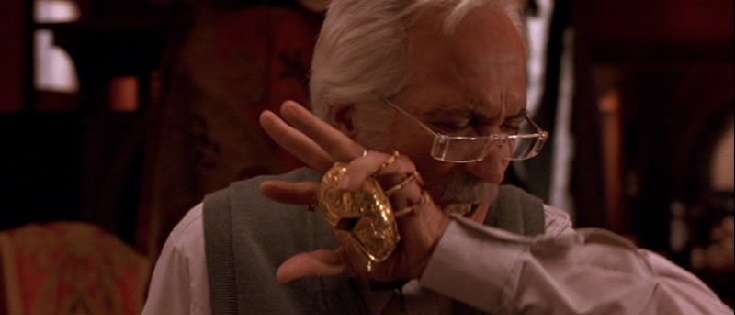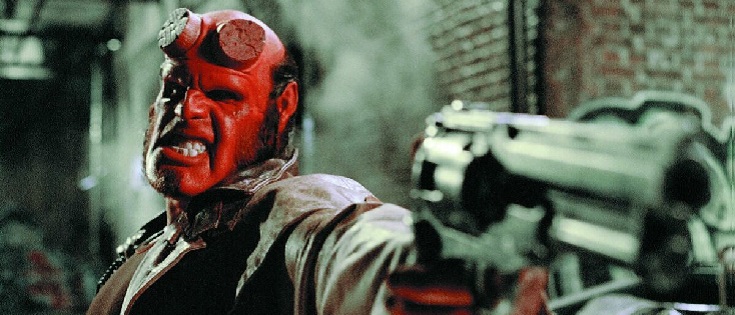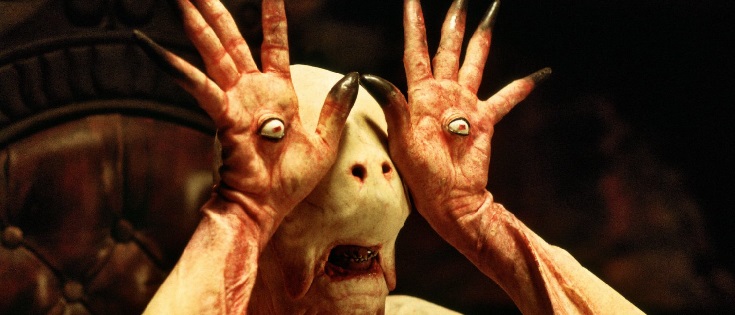in-store offers
Guillermo del Toro
5 of the best

Cronos (1993)

During the mid 1990s, Guillermo del Toro was one of a number of upcoming Mexican filmmakers working on the splendidly-named La Hora Marcada TV show. A horror/sci-fi anthology series along the lines of The Twilight Zone, del Toro’s handful of episodes showcased the fledgling filmmaker’s gifts for fantastical monsters and unusual mythologies. Cronos, his debut as writer-director, similarly laid out the roots of del Toro’s aspirations, although it lacks the resources to fully realize his remarkable vision.
The film stars Federico Luppi, a veteran Spanish-language actor who worked again with del Toro on The Devil’s Backbone and Pan’s Labyrinth. In Cronos, he plays Jesus Gris, an antiques dealer who finds a clockwork device that turns him into a vampire. Luppi’s courtly, measured performance might call to mind one of the great horror masters of old, Vincent Price or John Barrymore, perhaps. But – and when did the undead ever have it easy? – the Cronos device is also sought by Dieter – a dying industrialist, who covets its gift of immortality. As it transpires, Jesus finds himself pursued by Angel (Ron Perlman), Dieter’s nephew.
Jesus? Angel? Vampires? You can perhaps see where del Toro is going with this, creating a rich, mythic landscape against which his macabre drama unfolds. The Cronos device itself – encrusted with gold, spun around a living insect that feeds off its host by stabbing metal spikes into their veins – is inspired. Similarly, del Toro’s mix of poetic imagery, gothic horror and pulp conventions is assured. Perhaps the film’s strongest asset, though, has become something of a hallmark for the director: the monster is really the most vulnerable, human character in the film.
The Devil's Backbone (2001)

Although some admirers would cite Pan’s Labyrinth as the perfect manifestation of del Toro’s interests in the fabulous and the otherworldly, The Devil’s Backbone – in its quiet, melancholic way – is every bit the filmmaker’s early masterpiece. Set during the Spanish Civil War, the focus is a young boy who is taken to a leftist orphanage after the death of his father in battle. Carlos (Fernando Tielve) his new home – in a remote, rural part of Spain – full of terrible secrets and more besides. Chief among these is “the one who sighs” – a whispering phantom who may just be the ghost of an orphan who went missing weeks before Carlos arrived.
What follows is del Toro’s most intimate film. Short on spectacle and scale, it is tightly locked onto Carlos and the teachers and other children at the orphanage. This allows del Toro greater focus on his characters – brutish caretaker Jacinto (Eduardo Noriega), veteran Dr Casares (Cronos star Federico Luppi), one legged headmistress Carmen (Marisa Paredes). The ghost – for, yes, there is one – has a tragic story to tell that in various ways implicates many others present in the orphanage. Around them, del Toro creates an environment that while it is grounded in a real world setting nonetheless is abutted by supernatural elements. Much as del Toro enjoys mixing reality with the supernatural, so The Devil’s Backbone is also a mélange of different dramatic narratives: it is partly a political drama, partly a gothic horror and partly a coming-of-age story. That he successfully balances all of these opposing and contradictory concerns is credit to del Toro’s skills as an adept filmmaker. He would go on to make bigger films, of course; but perhaps none of them would ever quite recapture the minor key magic of The Devil’s Backbone.
Hellboy (2004)

Del Toro’s first foray into Hollywood had been 2007’s Mimic – a more conventional horror film about mutant cockroaches on the rampage in New York City. The experience was not ideal – he returned to Spanish language cinema for The Devil’s Backbone before being lured back to direct Blade 2. For a director whose Spanish language films had been so exquisite, the idea of del Toro tackling a Marvel Comics character (albeit a human-vampire hybrid) might have seemed a stretch. But bringing his own deft, idiosyncratic vision to pulpy narratives has now become a routine part of del Toro’s creative vision – what is The Shape Of Water, for instance, if not a 1950s sci-fi B-movie given the director’s own inimitable spin?
But 2004’s Hellboy, based on Mike Mignola’s series, allowed del Toro a different perspective on comic book fantasia. If Blade 2 was a shoot-‘em-up intertwined into vampire mythology, Hellboy was something else entirely freed from more familiar horror conventions. Involving a Nazi assassin with a wind-up key in his heart, a pyrokinetic special agent and a demon from another dimension, Hellboy was hardly the most conventional superhero punch-up. But evidently this is catnip – or, at least, psychic amphibious humanoid nip) for Del Toro. After all, it was a copy of Famous Monsters Of Filmland that set del Toro – aged seven – off on his creative journey. Here he is quite literally in his element as he brings Mignola’s colourful menagerie to life.
The plot? Well, it concerns a decades-old Nazi plot to initiate the reign of giant evil squid gods – which Hellboy (played with blue collar gruffness by Ron Perlman) and his associates must foil. And who else would you want on your side when facing down multi-dimensional evil entities than a red skinned demon with sawn-off horns and a right hand that’s made of stone?
Pan's Labyrinth (2006)

Arguably, the high water mark of Del Toro’s Spanish-set fantastias, Pan Labyrinth was set during the Spanish Civil War and featured a young protagonist drawn into a world of the supernatural. But there its similarities to The Devil’s Backbone end. While Del Toro’s earlier film existed in a recognizably familiar world, much of Pan’s Labyrinth takes place in an underground world – which becomes a retreat for 11 year-old Ofélia (Ivana Baquero). There she can escape her wicked step-father – Vidal (Sergi López), a vicious captain in Spain’s Civil Guard – and explore this beautiful and frightening netherworld. There she meets a faun, who suggests Ofélia is nothing less than a lost princess of this realm. To reclaim her title and station, she must complete three dangerous tasks…
Del Toro’s reference points are of course recognisable – including Lewis Carroll, CS Lewis and even Clive Barker. But it is possible to see the manner in which Del Toro deploys them as a means to serve his own narrative concerns. Much as the labyrinth is beneath the human world, so Del Toro is concerned with boldly juxtaposing these real and unreal environments; what does Fascism say about these creatures and what do these creatures say about Fascism?
Talking of the creatures, the film also provides a foregrounded role for Doug Jones, an increasingly familiar presence in Del Toro’s movies. The actor and former contortionist previously played supporting roles in Mimic and Hellboy, but here does more central work as both the duplicitous faun and the terrifying Pale Man – an albino demon with eyeballs in the palms of his hands. Indeed, it is these formidable creations – part nightmare, part allegory – that sealed the success of Pan’s Labyrinth and ushered in a new mature phase in Del Toro’s filmmaking.
The Shape of Water (2018)

Del Toro’s trajectory after Pan’s Labyrinth continued to mix spectacular, big budget films with more intimate arthouse fare. A Hellboy sequel was followed by the sci-fi epic Pacific Rim and then a dark, small-scale horror story, Crimson Peak (we shall ignore The Hobbit, as that never happened…). For The Shape Of Water, Del Toro gives us yet another spin on the tropes of classic B-movie filmmaking.
The Shape Of Water introduces us to an amphibian-humanoid creature (Doug Jones, again), hailing from the Amazon, who is captured and brought to a secret facility near Baltimore during the height of the Cold War. There, a cabal of American military and scientific minds believe he will prove an invaluable asset against the Russians. What no one counts on is that the creature will fall in love with one of the cleaning ladies at the facility; Eliza (Sally Hawkins).
Aside from its obvious antecedents in 1950s sci-fi monster movies, Del Toro’s film plays as an open love-letter to cinema’s wider range. Eliza and her neighbour, Giles (Richard Jenkins), live above a cinema that plays films to empty houses. A black and white fantasy song and dance sequence wouldn’t look out of place in one of the MGM musicals Giles devours. Eliza herself has a namesake in Pygmalion/My Fair Lady’s Eliza Doolittle. Events in the shadowy Baltimore facility, meanwhile, are redolent of Cold War-era noirs – complete with Russian spies and buzz-cut five star generals. But while Del Toro’s flight of fancy is fully formed, it is abutted by the real world –racism and homophobia are evidence of a particularly closed mindset. As with many of Del Toro’s characters, Eliza seeks escape – which her new, fabulous beau offers. What could be Amelie-style tweeness is invested with warmth, beauty and a surprisingly deep emotional richness.
Michael Bonner
